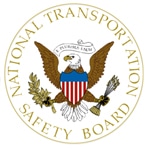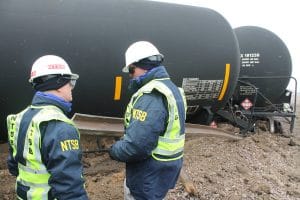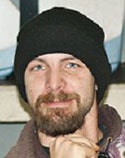As the National Transportation Safety Board continues to investigate an accident in Wyoming that killed two SMART TD members out of Local 446, it issued a pair of safety recommendations to Class I railroads and a recommendation to the American Short Line and Regional Railroad Association regarding train emergency brake communication.
Benjamin George “Benji” Brozovich, 39, and Jason V. Martinez, 40, both members of the Cheyenne, Wyo., local, died in the Oct. 4, 2018, accident. The NTSB recommendations follow.
To the Class I Railroads:
Review and issue guidance as necessary for the inspection of end-of-railcar air hose configurations to ensure the air hose configuration matches the intended design. (R-19-41)
Review and revise your air brake and train handling instructions for grade operations and two-way end-of-train device instructions to include: monitoring locomotive air flow meters, checking the status of communication between the head-of-train and end-of train devices before cresting a grade, and the actions to take if the air pressure at the rear of the train does not respond to an air brake application. (R-19-42)
To the American Short Line and Regional Railroad Association:
Alert your member carriers to (1) inspect the end-of-railcar air hose configurations to ensure the hose configurations match the intended design and (2) review and revise their air brake and train handling instructions for grade operations and two-way end-of-train device instructions to include: monitoring locomotive air flow meters, checking the status of communication between the head-of-train and end-of-train devices before cresting a grade, and the actions to take if the air pressure from the rear of the train does not respond to an air brake application. (R-19-43)
The NTSB investigation into the accident is ongoing. It issued a preliminary report on the accident last November.
Read the safety recommendations on the NTSB website.
Tag: Union Pacific
Andrepont, 39, of DeQuincy, La., had worked for Union Pacific for 16 years, a UP company spokeswoman told The Associated Press.
Brother Andrepont became a member of SMART Transportation Division in January 2006 and had been the local’s S&T since January 2018. A conductor, he also was secretary of LCA 577 (sUnion Pacific-MP).
“His love for his wife and his children, surpassed everything else,” his obituary read.
He is survived by the love of his life, Paiton Andrepont; one son, Riley; two daughters, Shiloh and Amelia; his mother, Lesa Russell and step father, J. Russell; grandparents, Walton and Dellie Baggett and Audrey Andrepont, all of DeQuincy; one brother, Brian Andrepont of Houston; two sisters, Dawn Lewis and husband David of DeRidder, and Ashley Broussard and husband Jason of Lake Charles.
An online fundraiser has been established to assist his family in their time of mourning.
SMART TD expresses great sorrow at this tragic loss and extends condolences to Brother Andrepont’s family, friends, local and all who knew him.
Condolences for Brother Andrepont’s family and friends may be left at this website.
The NTSB was notified of the accident, and local authorities are investigating, according to law enforcement.
In the carrier’s quarterly earnings call April 18, Union Pacific Chief Operating Officer Jim Vena said that more cuts are being weighed as UP quests for a 61% operating ratio and continues its move toward Precision Scheduled Railroading (PSR).
During the call, the carrier also announced a “pause” in the construction of its $550 million Brazos Yard project in Robertson County, Texas, as UP reallocated funds to improve its El Paso, Texas-to-Loa Angeles line.
Vena said there would be more “rationalization” of the carrier’s network and terminals in order to increase train speed and that future hump yard closures are in the planning stages, according to the Supply Chain Dive news website.
UP is a third of the way through its “Unified 2020” plan to implement PSR, Supply Chain Dive’s Emma Cosgrove reported.
Read Supply Chain Dive’s coverage of the UP earnings call here.
Certain Union Pacific (UP) workers who were employed by the carrier from 1991 to 2017 might get some money back in their pockets thanks to a ruling made in the United States Court of Appeals for the Eighth Circuit.
If they meet certain criteria and were taxed on particular stock options or ratification bonuses, current and former UP workers will receive a refund after the appeals court sided with UP in the summer of 2017 and reversed a district court’s ruling in a fight over taxes with the Internal Revenue Service (IRS).
At the heart of the matter was whether stock options or ratification bonuses received by UP workers should have been treated as taxable income under the Railroad Retirement Tax Act. The IRS argued successfully in district court that this was the case and received a summary judgment of about $75 million in taxes owed by the carrier. However, UP appealed the decision, and the appeals court reversed the district court’s ruling.
In June 2018, the U.S. Supreme Court denied a petition by the IRS to hear the case, settling the matter in favor of UP and paving the way for the potential payouts.
In order to determine their eligibility for a refund, people who were employed by UP from 1991 to 2017 must file a consent form by visiting www.unionpacifictaxrefund.com. The consent form must be turned in by a March 12, 2019, deadline in order to receive a refund, which is scheduled to be disbursed between June and August 2019.
For additional information, see the FAQ about the refund program by following this link.
For additional questions, contact Union Pacific’s tax refund administrator by emailing info@UnionPacificTaxRefund.com or call 888-724-0236 (toll-free).
Retirees who claim refunds on stock options have been advised their annuities could be reduced.
Follow this link to read the appeals court ruling (PDF).
The Surface Transportation Board (STB) chairwoman has asked Norfolk Southern’s CEO to keep the board apprised as the carrier begins to add elements of Precision Scheduled Railroading (PSR) to its operations, Trains Magazine reports.
The letter from Ann Begeman, sent Nov. 27 to NS CEO Jim Squires, requests that the carrier begin weekly conference calls with the STB to report operational changes, the magazine reported in an article posted Nov. 29.
The requirement of updates from NS mirrors the approach STB has taken in handling another Class I that is trying out PSR.
Union Pacific (UP) announced in early autumn that it also had begun adopting aspects of PSR as part of its “Unified Plan 2020” initiative. PSR is a strategy by the late CSX CEO E. Hunter Harrison that he implemented at both Canadian National and Canadian Pacific and requires cargo to be ready when rail cars arrive for loading or risk being left behind, among other aspects. Both Canadian carriers reported financial benefits after these implementations.
When Harrison moved to CSX in early 2017 and began adding PSR to that carrier’s operations, CSX received substantial criticism from shippers amid reports of service problems as the year progressed. This drew the attention of STB and resulted in a hearing before the STB to address the carrier’s difficulties.
To avoid a repeat of those problems encountered by CSX, a letter from the STB sent in September to UP sought weekly updates on the implementation.

The report states that data retrieved from the event recorder of the train indicated that an emergency brake application failed to slow the train as it descended a grade west of Cheyenne before striking the rear of a stationary train.
“Normally, the locomotive would send a message to the end-of-train device to also apply the brakes with an emergency brake application,” NTSB said in the preliminary report. “According to the event recorder, the end-of-train device did not make an emergency application of the brakes. Investigators are researching the reason for the communication failure. After the engineer applied the emergency application, the train continued to accelerate until reaching 56 mph as the last recorded speed.”
Positive train control (PTC) was active at the time of the accident, NTSB said.
NTSB said further investigation will focus on components of the train’s air brake system, head-of-train and end-of-train radio-linked devices, train braking simulations and current railroad operating rules. Investigators will also determine if the railroad’s air brake and train handling instructions address monitoring air flow readings and recognizing the communication status with the end-of-train device, the report stated.
Three locomotives and 57 cars of the striking train derailed. Nine cars of the stationary train derailed.
The investigation into the collision is continuing, and a final report will be released by NTSB at a later date.
Follow this link to read the preliminary report.
The National Transportation Safety Board (NTSB) on Oct. 30 ruled that flaws in Union Pacific’s approach to inspecting, maintaining and repairing defects on the Estherville Subdivision helped to cause a March 2017 derailment that resulted in multiple tank cars spilling undenatured ethanol in Graettinger, Iowa.
A rail near a transition onto a bridge broke, causing 20 tank cars to derail in the accident that happened at 12:50 a.m. local time March 10, 2017. Fourteen of the tank cars spilled 322,000 gallons of ethanol, causing a fire that burned for more than 36 hours. Three nearby homes were evacuated as a result of the accident, which caused an estimated $4 million in damage, including the destruction of 400 feet of track and a 152-foot railroad bridge.
During the NTSB hearing, board member Jennifer Homendy said she made a review of a decade’s worth of accident data for UP and the numbers showed one thing in common.
“Every year, track defects are the chief cause of accidents with UP,” she said.
Along Estherville’s 79-mile stretch, Homendy said that 102 defects of “marginal” and “poor” crossties were identified over a two-year period from 2015-17.
After the carrier received the reports of rail or crosstie defects, chief accident inspector Michael Hiller said UP didn’t take enough steps to fix the problems prior to the accident.
“The inspectors were going out and they were doing their inspections, and they were reporting the conditions of the tie,” Hiller said. “In many cases – more than 100, as member Homendy pointed out – there were remediation efforts, and it’s clear based on our observations post-accident that the remediation efforts restored the track back to its minimum condition that it needed to sustain traffic.
“We’re looking to see that things are not just restored back to the minimum…we know that doesn’t work. If you’re finding 10 or 12 crossties in a 39-foot section of track that are defective, it’s not a good practice to go in and replace two or three just to restore the track.”
Also contributing to the accident was what NTSB described as “inadequate oversight” on the part of the Federal Railroad Administration (FRA).
While FRA inspectors raised the carrier’s attention to track defects — the agency had just initiated a compliance agreement in late 2016 as a result of a fiery oil train derailment in Mosier, Ore. — and some action was taken, Hiller said not all enforcement measures, such as civil penalties, were used.
NTSB investigators also noted that FRA inspectors neglected to report some defective crosstie conditions.
After the Graettinger accident, Hiller said that the carrier has shown “very good response” to reports of tie defects and maintenance and has performed twice-weekly inspections on the subdivision in a post-accident agreement with FRA.
However, the NTSB did note that there was one week where the carrier inspected the subdivision only once.
“The extent of post-accident actions, while welcome, hints at the inadequacy of UP’s pre-accident maintenance and inspection program,” NTSB Chairman Robert Sumwalt said. “The railroad is supposed to look for and fix unsafe conditions as a matter of course.”
Finally, the use of U.S. DOT 111 tanker cars to transport the ethanol also worsened the environmental impact of the accident, investigators said.
Hiller said that 10 of the 14 tankers that breached met old DOT 111 specifications “identified as having a high probability of releasing hazardous materials.”
DOT 117 specifications established by the Pipeline and Hazardous Material Safety Agency (PHMSA) add reinforcement and other design features to cars transporting both crude oil and ethanol.
“The tougher design would have prevented the release,” Sumwalt said.
FRA identifies ethanol as the most hazardous material that is transported by rail in the United States. The denaturing process adds toxic compounds to make it unfit for human consumption and also lessens the tax burden for the carriers transporting it because it is not a beverage.
In the Graettinger accident, the ethanol was undenatured, meaning that the toxins were not added to the alcohol being transported.
“This seems to have had a beneficial effect on safety,” Sumwalt said. “Investigators found milder damage in this accident than in previous accidents with the same type of tank cars, but those involved denatured alcohol.”
It was suggested that a safety benefit might be achieved by getting rid of denaturants when transporting ethanol.
“Never before have I seen a regulation to make a hazardous material more hazardous,” Robert Hall, an expert in hazardous materials transport, said of the denaturing process. “It doesn’t make sense.”
A May 1, 2023, regulatory deadline has been set for all DOT 111 tank cars that carry ethanol to be changed over or retrofitted to meet the higher DOT 117 standards. In order to achieve that deadline, about 350 tank cars per month must be changed over.
Recommendations
At the hearing, NTSB issued three new safety recommendations and reiterated one safety recommendation to the FRA, PHMSA and UP. They address training on safety standards and available enforcement options for federal track inspectors, the need for research to determine if safety would be improved by transporting ethanol in an undenatured state, and the need for Union Pacific to re-examine track maintenance and inspection program standards on all routes carrying high hazardous flammable materials.
“The recommendations just issued, if acted upon, will result in better training for FRA track inspectors and clear guidance involving available enforcement options,” Sumwalt said. “They will result in UP re-examining its track maintenance and inspection program standards. Today’s recommendations will result in research by PHMSA into whether alcohol — ethanol — should be transported in an undenatured state and furthermore, a recommendation first issued in 2015 and reiterated today will result in progress milestone schedules for the phasing out of the DOT 111 tank cars for ethanol service by 2023, if acted upon.
“Otherwise, we risk a so-called sudden realization that isn’t sudden at all. We could have seen this train coming down the track.”
NTSB’s report states alcohol or drug use, and cell phone use were not factors in the accident, nor was the mechanical condition of the train, the performance of the train crew or the emergency response a factor. The full report will be available on the NTSB website when finalized.
SMART Transportation Division is mourning the loss of two members who were killed in a deadly train collision that occurred Oct. 4 west of Cheyenne, Wyo.
Benjamin Brozovich, 39, of Lusk, Wyo., and Jason V. Martinez, 40, of Cheyenne, died when their Union Pacific freight train collided into the back of another stopped UP train.
Martinez was a 12-year member out of Local 446. Brozovich had been a member of the same local for three years.
Members of the SMART TD National Safety Team were dispatched and assisting the National Transportation Safety Board in its investigation, said Vice President John England.
Wyoming State Legislative Director Stan Blake described the crash as “horrific.”
The investigation is continuing.
Brother Nicholas A. Vosejpka, of Hampton, Minn., a switchman with SMART TD Local 1614, died while on duty Dec. 30, 2017, as he worked as a yard foreman at Union Pacific’s Hoffman Yard in St. Paul, Minn.
Vosejpka, 35, was walking in the yard performing an air-test in temperatures well below zero with gusting wind at approximately 7:30 p.m. CST, Local 1614 Chairman Brad Nelsen reported. A student and new-hire switch person were with Brother Vosejpka when he collapsed, Nelsen said.
Emergency personnel responded and were unable to revive Vosejpka. UP yard crews were tied up thereafter.
“Brother Vosejpka was a hard worker, good man and a good rail worker,” said Nelsen.
Brother Vosejpka is survived by his mother, Brenda, young children Carter and Madison and extended family.
Funeral services will be at Rejoice Church in Dundas on Friday, January 5, 2018, beginning at 11 a.m. Visitation will be Thursday, January 4, 2018, from 4 p.m. to 8 p.m. at Bierman Funeral Home and one hour prior to the service in the church. Burial will be at Calvary Cemetery in Lonsdale. In lieu of flowers, memorials are preferred.
A full obituary is available here.
Brother Vosejpka was the seventh SMART TD member who died while on duty in 2017.


